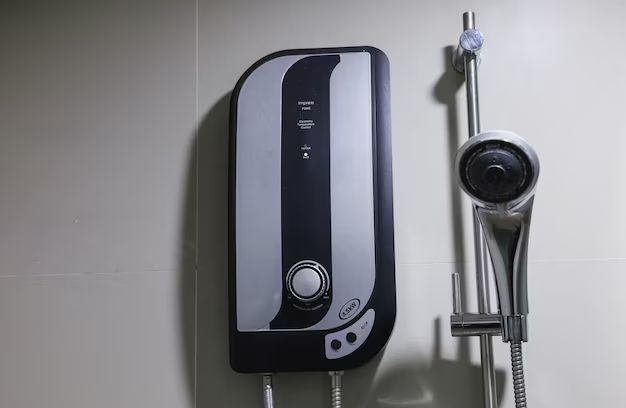When it comes to heating a bathroom, there are a few options available that meet safety requirements. Proper bathroom heating is important for comfort and to reduce moisture that can lead to mold growth. The right type of heater can keep your bathroom warm without endangering you or your family.
Page Contents
Electric Heaters
Electric heating is one of the most common and cost-effective ways to heat a bathroom. Electric heaters are designed for bathroom use and meet safety standards for use around moisture. Here are some types of electric heaters that can be safely installed in a bathroom:
Electric Wall Heaters
Wall-mounted electric heaters are a popular choice for heating small to medium-sized bathrooms. They can be installed high up on a wall or near the floor. Wall heaters come in hardwired and plug-in options and different sizes based on heating needs. Hardwired heaters provide more power but require professional installation, while plug-in wall heaters are easier to install DIY. Key features include:
- 120-250V hardwired or standard plug-in
- IP55 waterproof rating
- Automatic shutoff if tipped over
- Thermostat or manual controls
- Safety certification for bathroom use
- 500-1500W power
Electric Ceiling Heaters
Ceiling-mounted electric heaters are a discrete option to warm a bathroom. They go directly into the ceiling and don’t take up wall space. Ceiling heaters are available in hanging or recessed styles. They heat the room using infrared radiation or convection. Key features include:
- 120-240V hardwired connection
- IP44 or IP55 waterproof rating
- Automatic shutoff
- Built-in thermostat
- 500-2000W power
- Safety certification
Electric Fan Heaters
Fan heaters (also called ceramic heaters) use an electric heating element and fan to circulate warm air. They can be mounted on walls or placed on the floor. Fan heaters heat up quickly and are inexpensive to run. Key features include:
- 120V plug-in
- IP21 waterproof rating
- Tip-over shutoff
- Adjustable thermostat
- Up to 1500W power
- ETL/UL certified for bathrooms
Radiant Floor Heating
Electric radiant floor heating systems use heating elements under the floor to gently warm the room. They provide even, comfortable heat. While more expensive to install, radiant systems can be very energy efficient. Key features include:
- 120-240V hardwired system
- Works under tile, stone, or laminate floors
- Programmable thermostat control
- Long lifespan (20+ years)
- Safety tested for bathrooms
Gas Heaters
Gas bathroom heaters provide an efficient, comfortable heat source similar to electric options. Not all homes have gas lines, so availability is a consideration. Gas heaters must be properly vented and installed by professionals. Here are some common gas heater options:
Gas Wall Heaters
Gas wall heaters work similarly to electric wall heaters but use natural or propane gas for fuel. They have a sealed combustion chamber and use a fan to push heated air into the room. Key features include:
- 30-40,000 BTU heating power
- Vented with 4-6 inch ducts
- Built-in thermostat
- Safety auto shutoff
- EEF/ANSI safety certification
Gas Ceiling Heaters
Gas ceiling heaters are available in hanging and recessed models. They vent vertically through the roof or horizontally through an exterior wall. Key features include:
- 17,000 to 34,000 BTU heating power
- Gravity or power venting
- 24V thermostat control
- Optional humidifier
- CEC approved for bathrooms
Radiant Floor Heating
Gas-fired radiant floor heating works like electric systems but uses natural gas instead. Hot water or antifreeze solution is heated in a boiler and pumped under the floor. Key features include:
- Hydronic or air-heated systems
- Even, comfortable warmth
- Programmable thermostat
- Durable pipes last 20-50 years
- Energy efficient
Other Heater Options
In addition to electric and gas heaters, a few other heater types can be used safely in bathrooms:
Oil-Filled Radiators
Oil-filled electric radiators use heating oil to evenly distribute warmth. They have overheat protection and are certified for bathroom use. Key features include:
- 120V plug-in
- Sealed oil chamber
- Set temperature dial
- Automatic shutoff
- Tip-over switch
- 900-1500W power
Infrared Radiant Heaters
Infrared heaters use ceramic plates or tubes heated by electricity to produce radiant heat. They warm people and objects, not the air. Models rated for bathroom use are available. Features include:
- 120-240V plug-in or hardwired
- IP55 rating
- Wall-mounted or freestanding
- Automatic shutoff
- Up to 2000W power
Hydronic Radiators
Hydronic or hot water radiators use heated fluid circulated from a central boiler. They offer uniform warmth and high efficiency but require professional installation. Key features include:
- Hydronic central heating system
- Wall-mounted radiators
- Commercial models for bathrooms
- Energy efficient
- Durable steel or cast iron
Bathroom Heater Safety
When installing any heater in a bathroom, safety is critical. The risk of electrical shock and fire must be minimized through proper selection and installation. Here are key safety tips:
- Choose an electric heater rated IP44 (splash proof) or IP55 (water jet resistant) or higher.
- Select a hardwired or GFCI protected circuit for power.
- Install the heater high up, at least 6 feet away from shower/tub.
- Allow sufficient clearance from curtains, sinks, etc per manufacturer instructions.
- Choose an electrical heater with auto shutoff if tipped over.
- Have gas heaters properly vented and installed by qualified pros.
- Carefully follow all building codes for bathroom electrical and heating.
Conclusion
The most common and safest types of heaters for a bathroom include electric wall or ceiling heaters, fan heaters, radiant floor heating, gas wall/ceiling heaters, oil-filled radiators, and infrared heaters. Choosing a UL/ETL certified bathroom model and having it installed properly ensures safe, comfortable heating. Considering factors like room size, efficiency, and upfront cost helps select the right bathroom heating solution.
